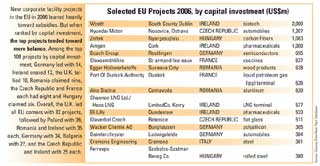EUROPEAN UNION
Jobs and Learning
Eder says the restrictions often encountered in the EU still have to do with socio- political issues, or "getting the social ideal to work well with the economic needs of businesses." While central and eastern Europe may need some reform on the labor side, he says, they are "not too far off from the standards of the market."
The issue across the EU, meanwhile, is what he calls an "enormously high level of job protection. How easily can you terminate the person? It's getting worse in western Europe than it is in eastern Europe, because of the social system that has developed over the past 50 years. The No. 2 problem is unemployment.
 |
| SELECTED EU PROJECTS 2006:
Click the image above for a full-sized chart. |
Graham Hay points out that related issues are present even in surging economies like Poland's:
"In Poland currently only around 60 to 65 percent of the working- age population is economically active [working or looking for work]," he says, "compared to 70 to 75 percent for established EU members. Thus, there is scope for the Polish government to address current shortages through measures to raise the activity rate, and thus the employment rate."
While the social support system, expensive though it is, works in many instances, Eder and others point to another area needing reform: education. "One problem is it stops at a certain age, and education of the work force is not sufficiently organized," he says.
Eder points to the OECD's Program for International Student Assessment (PISA), which assembles a report every three years evaluating performance of 15- year- olds in leading OECD nations. The organization's next report for 2006, covering 60 nations, has yet to be published. Its 2003 report, with a special emphasis on mathematics proficiency, found the highest performance quotient in Finland, with the Netherlands and Switzerland the only other European nations to crack the top 10. However, the next 10 top performers were almost exclusively made up of European nations, led by Iceland, Denmark, Belgium, the Czech Republic and France, followed by Ireland, Sweden, Austria and Slovakia.
All were ranked above the United States.
|
Something In the Air
In 2005, the total number of passengers transported by air in the EU25 rose by 8.5 percent compared to 2004, to more than 700 million. Of these passengers, 23 percent were carried on national flights, 42 percent on intra- EU25 flights and 35 percent on extra- EU25 flights. London/Heathrow remained the EU's busiest airport, handling 68 million passengers in 2005, up 1 percent compared to 2004. Paris/Charles de Gaulle (53 million passengers, +5 percent) and Frankfurt (52 million, +2 percent) were the second and third busiest airports, followed by Amsterdam/Schipol (44 million, +4 percent) and Madrid/Barajas (42 million, +9 percent). Air freight in the EU25 rose by 3.5 percent in 2005 compared to 2004, to almost 11 million metric tons, 80 percent of which was with non- EU25 countries. Freight volumes rose by 9.6 percent in 2004. The main partners were North America, down 2 percent compared to 2004, and representing 30 percent of freight traffic with non- EU25 countries; the Far East (+7 percent, 28 percent of this traffic) and the Near and Middle East (+4 percent, 14 percent of this traffic). Frankfurt (2.0 million metric tons, +7 percent compared to 2004) was in 2005 the EU's leading airport for air freight, followed by Amsterdam/Schipol (1.5 million, +2 percent), London/Heathrow (1.4 million, - 2 percent) and Paris/Charles de Gaulle (1.2 million, - 5 percent). |

